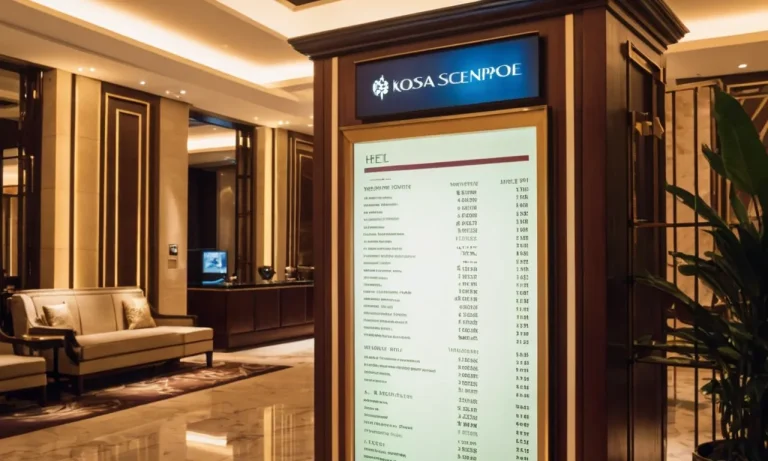How To Value A Hotel: A Comprehensive Guide
Determining the true value of a hotel property is a complex process that requires a deep understanding of various factors, from location and market conditions to operational performance and financial metrics.
If you’re short on time, here’s a quick answer to your question: To value a hotel, you need to consider factors such as revenue streams, operating expenses, occupancy rates, market positioning, and capitalization rates.
The most common methods used are the income capitalization approach, the sales comparison approach, and the cost approach.
In this comprehensive guide, we’ll delve into the intricacies of hotel valuation, exploring the different approaches, key metrics, and industry best practices. Whether you’re an investor, a hotel owner, or simply curious about the process, this article will provide you with a solid foundation to understand and navigate the complexities of hotel valuation.
Understanding the Fundamentals of Hotel Valuation
In the dynamic hospitality industry, accurately valuing a hotel property is crucial for making informed investment decisions, securing financing, and maximizing returns. Hotel valuation is a complex process that considers various factors, ranging from location and market demand to operational performance and property condition.
By grasping the fundamentals of hotel valuation, you can gain a comprehensive understanding of a property’s true worth and make strategic decisions accordingly.
The Importance of Hotel Valuation
Hotel valuation plays a pivotal role in several scenarios, including acquisitions, dispositions, refinancing, asset management, and portfolio analysis. Whether you’re a prospective buyer, seller, lender, or investor, an accurate valuation is essential for making well-informed decisions and mitigating risks.
It helps determine a fair market value, assess potential returns on investment, and evaluate the overall financial viability of a hotel property.
Key Factors Influencing Hotel Value
- Location: A hotel’s location is one of the most significant determinants of its value. Proximity to major attractions, transportation hubs, and business centers can significantly impact occupancy rates and revenue potential.
- Market Demand: The demand for hotel rooms in a specific market plays a crucial role in determining a property’s value. Factors like tourism trends, business activity, and local events can influence market demand and, consequently, a hotel’s performance.
- Property Condition and Amenities: The age, condition, and quality of a hotel’s facilities, as well as the range of amenities offered, can greatly affect its perceived value and appeal to guests.
- Operating Performance: A hotel’s financial performance, including occupancy rates, average daily rates (ADRs), and revenue per available room (RevPAR), are critical indicators of its value and profitability.
Common Valuation Methods
Several valuation methods are employed in the hotel industry, each with its own strengths and limitations. The most widely used methods include the income capitalization approach, the discounted cash flow (DCF) analysis, and the sales comparison approach.
According to a study by HVS, a leading global hospitality consulting firm, the income capitalization approach is the most prevalent method, accounting for approximately 60% of hotel valuations.
| Valuation Method | Description |
|---|---|
| Income Capitalization | This method estimates a hotel’s value based on its expected future income stream, considering factors like occupancy rates, ADRs, and operating expenses. |
| Discounted Cash Flow (DCF) | The DCF analysis estimates a hotel’s value by projecting future cash flows and discounting them to their present value using an appropriate discount rate. |
| Sales Comparison | This approach compares the subject property to similar hotels that have recently sold in the same market, making adjustments for differences in location, size, and amenities. |
Ultimately, the choice of valuation method depends on the specific circumstances, available data, and the purpose of the valuation. Many professionals employ a combination of methods to arrive at a comprehensive and reliable estimate of a hotel’s value. 😊
The Income Capitalization Approach
The income capitalization approach is one of the most widely used methods for valuing a hotel property. This approach is based on the principle that the value of an income-producing asset, such as a hotel, is directly related to the expected future income it will generate.
In other words, the value of a hotel is determined by its ability to generate revenue and profit.
Calculating Net Operating Income (NOI)
The first step in the income capitalization approach is to calculate the hotel’s net operating income (NOI). NOI is the amount of income left after deducting all operating expenses from the hotel’s gross revenue.
To calculate NOI, you need to have a thorough understanding of the hotel’s financial statements, including its income statement and balance sheet.
According to Hotel News Resource, the average NOI for U.S. hotels in 2022 was around 35% of total revenue. However, this figure can vary significantly depending on factors such as location, property type, and operational efficiency.
- Gross Revenue: This includes all income generated from room rentals, food and beverage sales, and other services provided by the hotel.
- Operating Expenses: These include costs such as payroll, utilities, marketing, and maintenance.
NOI = Gross Revenue – Operating Expenses
Determining the Capitalization Rate
The next step is to determine the appropriate capitalization rate, also known as the “cap rate.” The cap rate is a measure of the expected rate of return on an investment property. It is calculated by dividing the NOI by the property’s value or sale price.
Determining the cap rate can be a complex process, as it involves analyzing various risk factors and market conditions. Some key factors that influence the cap rate include:
- Location and market demand
- Property condition and age
- Competition from other hotels in the area
- Overall economic conditions
According to Hotel Management, the average cap rate for U.S. hotel transactions in 2022 was around 7.5%. However, cap rates can vary significantly based on the specific property and market conditions.
Adjustments and Considerations
Once you have calculated the NOI and determined the appropriate cap rate, you can estimate the hotel’s value using the following formula:
Hotel Value = NOI / Capitalization Rate
However, it’s important to note that the income capitalization approach may require additional adjustments and considerations. For example, you may need to account for factors such as:
- Potential future income growth or decline
- Upcoming capital expenditures or renovations
- Changes in market conditions or competition
Additionally, it’s essential to cross-reference the results of the income capitalization approach with other valuation methods, such as the sales comparison approach or the cost approach, to ensure a comprehensive and accurate assessment of the hotel’s value.
Valuing a hotel can be a complex process, and it’s often recommended to seek the expertise of professional appraisers or valuation experts who have experience in the hospitality industry. By following the income capitalization approach and considering all relevant factors, you can gain a better understanding of a hotel’s true value and make informed investment decisions.
😊
The Sales Comparison Approach
The sales comparison approach is a widely used method for valuing hotels. It involves analyzing recent sales of similar properties in the same market area to estimate the value of the subject property.
This approach is based on the principle of substitution, which states that an informed buyer will not pay more for a property than the cost of acquiring a comparable substitute. The sales comparison approach is considered one of the most reliable methods for valuing hotels, as it reflects the actual market value of properties that have recently sold.
Identifying Comparable Sales
The first step in the sales comparison approach is to identify a set of comparable sales. These are properties that are similar to the subject property in terms of location, size, age, condition, amenities, and other relevant characteristics.
The comparable sales should ideally have occurred within the past 6-12 months and be located within the same or a similar market area as the subject property. According to Hotel Online, a reputable industry resource, it’s essential to select truly comparable properties to ensure an accurate valuation.
Adjusting for Differences
Once a set of comparable sales has been identified, the next step is to make adjustments to account for any differences between the comparable properties and the subject property. These adjustments can be made for factors such as:
- Location (proximity to attractions, transportation, etc.)
- Size (number of rooms, square footage, etc.)
- Age and condition
- Amenities (pools, restaurants, fitness centers, etc.)
- Operating performance (occupancy rates, average daily rates, etc.)
The adjustments can be made on a dollar-per-unit basis (e.g., $X per room) or as a percentage of the sale price. Accurate adjustments are crucial, as they can significantly impact the final value estimate. According to a Hotel News Resource article, experienced appraisers often rely on statistical data and market analysis to make appropriate adjustments.
Limitations of the Sales Comparison Approach
While the sales comparison approach is widely used and generally considered reliable, it does have some limitations. One of the main limitations is the availability of truly comparable sales data. In some markets, especially those with limited transaction activity, it can be challenging to find a sufficient number of recent, comparable sales.
Additionally, the approach assumes that the market conditions and trends that existed at the time of the comparable sales will continue to hold true, which may not always be the case. 😊 Despite these limitations, the sales comparison approach remains a valuable tool for valuing hotels, especially when used in conjunction with other valuation methods, such as the income capitalization approach.
The Cost Approach
The cost approach is one of the most widely used methods for valuing hotels. This approach estimates the value of a hotel property based on the cost of reproducing or replacing the existing structures on the land, factoring in depreciation and obsolescence.
It provides a reliable estimate of the minimum value a buyer would be willing to pay for the property.
Estimating Land Value
The first step in the cost approach is to determine the value of the land on which the hotel is built. This is typically done by analyzing recent sales of comparable vacant land parcels in the area. Factors such as location, size, zoning, and development potential are considered to arrive at an accurate estimate of the land’s value.
According to a study by Hotel Real Estate Value, land values in prime urban locations can account for up to 30% of a hotel’s total value.
Calculating Replacement Cost
Next, the cost of reproducing or replacing the hotel’s buildings and other improvements is estimated. This involves calculating the cost of materials, labor, and other construction expenses required to build a similar structure from the ground up.
Reputable sources like RSMeans provide detailed cost data for various building types and locations. The replacement cost estimate should also consider factors like architectural fees, permits, and financing costs.
According to Hotel Management, the average replacement cost for a mid-scale hotel in the U.S. was around $150,000 per room in 2022.
Accounting for Depreciation and Obsolescence
Finally, the cost approach accounts for depreciation and obsolescence, which reduce the value of the hotel over time. Depreciation refers to the physical deterioration of the property due to age and wear and tear, while obsolescence considers factors like changing market conditions, functional obsolescence (e.g., outdated design or technology), and external obsolescence (e.g., neighborhood decline). Depreciation and obsolescence can be estimated using methods like the age-life method, the market extraction method, or the breakdown method.
According to a study by Hotel News Resource, hotels typically experience an average annual depreciation rate of around 3-5%.
By combining the land value, replacement cost, and adjustments for depreciation and obsolescence, the cost approach provides a reliable estimate of the hotel’s value. However, it’s important to note that this approach may not fully capture the property’s income-generating potential or market demand, which are better reflected in the income and sales comparison approaches.
Conclusion
Valuing a hotel is a multifaceted process that requires a deep understanding of the industry, market conditions, and financial metrics. By combining the income capitalization approach, the sales comparison approach, and the cost approach, investors and hotel owners can gain a comprehensive understanding of a property’s value.
It’s important to remember that hotel valuation is not an exact science, and various factors can influence the final value. Engaging with experienced professionals, such as hotel appraisers and consultants, can provide valuable insights and ensure a thorough and accurate valuation process.
Ultimately, a well-executed hotel valuation can inform critical investment decisions, guide strategic planning, and help maximize the potential of a hotel property in an ever-evolving and competitive market.







